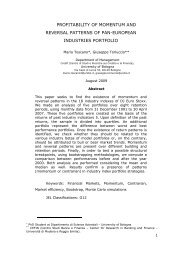large debt financing syndicated loans versus corporate bonds
large debt financing syndicated loans versus corporate bonds
large debt financing syndicated loans versus corporate bonds
Create successful ePaper yourself
Turn your PDF publications into a flip-book with our unique Google optimized e-Paper software.
European firms are better valued by equity markets and also tend to prefer public<br />
funding via the <strong>corporate</strong> bond markets. Therefore, <strong>syndicated</strong> loan markets stand as<br />
an alternative for bond markets when the borrowers are not so highly valued by the<br />
market, as more in depth knowledge of the borrower is warranted. 9<br />
We find that profitability increases firms’ likelihood of tapping <strong>syndicated</strong> loan<br />
markets. This is contrary to Denis and Mihov (2003), who report that profitable firms<br />
are more likely to issue public <strong>debt</strong>. Creditors participating in <strong>syndicated</strong> lending<br />
deals deem profitability to be a measurement of a firm’s ability to pay back its <strong>debt</strong> by<br />
generating income.<br />
Our results also suggest that higher capital expenditure leads to public <strong>debt</strong> funding by<br />
European firms. As with the market-to-book value, this probably captures the impact<br />
of the potential growth options through new investments. In other words, those firms<br />
with higher and visible capital investment spending, signalling further growth, prefer<br />
public <strong>debt</strong> markets. This explanation runs counter to the use of investment as a proxy<br />
to measure the concerns of information leakage on the choice of <strong>debt</strong> market. This<br />
literature hypothesises that firms with significant investment, in particular R&D<br />
investment, will have disclosure concerns. These firms may therefore prefer <strong>debt</strong> with<br />
fewer counterparties (i.e. <strong>syndicated</strong> or unilateral <strong>loans</strong>) as creditors. Indeed, using a<br />
direct proxy for R&D expenditure, earlier studies document a positive relationship<br />
between this variable and the use of bilateral bank <strong>debt</strong> (Denis and Mihov (2003) and<br />
Barclay and Smith (1995)). This latter explanation is likely to apply to the private<br />
unilateral bank but is probably less relevant in the case of the <strong>syndicated</strong> loan market.<br />
5.1.4 Size of firm and flotation costs<br />
Our findings for listed companies are twofold. Firstly, we find that <strong>large</strong>r firms are<br />
more likely to issue <strong>debt</strong> in the <strong>syndicated</strong> loan markets than the <strong>corporate</strong> bond<br />
market. Secondly, when including a <strong>large</strong>r sample with smaller firms from the <strong>large</strong>r<br />
dataset (see Table 4; this is discussed further in Section 5.4), the results show that size<br />
is positively related to the probability of issuing <strong>debt</strong> in both the <strong>corporate</strong> bond and<br />
<strong>syndicated</strong> loan markets. Therefore, <strong>syndicated</strong> <strong>loans</strong> seem to be the instrument of<br />
9 Growth in sales (a backward-looking growth indicator) is also found to increase the likelihood of<br />
20 ECB<br />
Working Paper Series No 1028<br />
March 2009

















